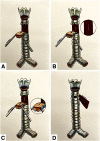Post-Intubation Tracheoesophageal Fistula: Surgical Management by Complete Cervical Tracheal Transection
- PMID: 36310067
- PMCID: PMC10902657
- DOI: 10.5761/atcs.cr.22-00134
Post-Intubation Tracheoesophageal Fistula: Surgical Management by Complete Cervical Tracheal Transection
Abstract
We report successful surgical management of post-intubation tracheoesophageal fistula (TEF) in an adult patient requiring long-term mechanical ventilation. A complete tracheal transection without tracheal resection, via an anterior cervical approach, followed by direct closure of tracheal and esophageal defect, and interposition of muscle flap between the suture lines and tracheal reconstruction was performed. In selected cases, this surgical procedure may be a viable alternative to traditional techniques used to treat post-intubation TEF via the anterior or lateral cervical approach.
Keywords: alternative technique; surgery; tracheoesophageal fistula.
Conflict of interest statement
We have no conflict of interest.
Figures



Similar articles
-
Acquired Benign Tracheoesophageal Fistula: An Alternative Tracheoplastic Technique.Ann Thorac Cardiovasc Surg. 2022 Dec 20;28(6):377-380. doi: 10.5761/atcs.nm.22-00077. Epub 2022 Sep 3. Ann Thorac Cardiovasc Surg. 2022. PMID: 36058880 Free PMC article.
-
[Possibilities and results of surgical treatment of benign tracheoesophageal fistula].Rozhl Chir. 2010 Aug;89(8):478-89. Rozhl Chir. 2010. PMID: 21121142 Slovak.
-
A Modified Tracheal Transaction Approach for the Repair of Nonmalignant Tracheoesophageal Fistulas: A Report of 5 Cases.ORL J Otorhinolaryngol Relat Spec. 2017;79(3):147-152. doi: 10.1159/000468943. Epub 2017 Apr 8. ORL J Otorhinolaryngol Relat Spec. 2017. PMID: 28391268
-
Surgical repair of mechanical ventilation induced tracheoesophageal fistula.Eur Arch Otorhinolaryngol. 2020 Feb;277(2):323-331. doi: 10.1007/s00405-019-05723-y. Epub 2019 Nov 8. Eur Arch Otorhinolaryngol. 2020. PMID: 31705278 Review.
-
Tracheoesophageal fistula.Chest Surg Clin N Am. 2003 May;13(2):271-89. doi: 10.1016/s1052-3359(03)00030-9. Chest Surg Clin N Am. 2003. PMID: 12755313 Review.
Cited by
-
Surgical management of acquired benign tracheoesophageal fistula: Technical aspects and suggestio.Ann Thorac Med. 2024 Apr-Jun;19(2):177-178. doi: 10.4103/atm.atm_301_23. Epub 2024 Apr 25. Ann Thorac Med. 2024. PMID: 38766370 Free PMC article. No abstract available.
-
Successful repair of acquired intrathoracic nonmalignant tracheoesophageal fistulas using thoracoacromial artery perforator flap through a midsternal incision approach: a report of three cases.J Thorac Dis. 2023 Sep 28;15(9):5122-5133. doi: 10.21037/jtd-23-1128. Epub 2023 Sep 11. J Thorac Dis. 2023. PMID: 37868901 Free PMC article.
References
-
- Macchiarini P, Verhoye JP, Chapelier A, et al. Evaluation and outcome of different surgical techniques for postintubation tracheoesophageal fistulas. J Thorac Cardiovasc Surg 2000; 119: 268–76. - PubMed
-
- Dhiwakar M, Ronen O, Supriya M, et al. Surgical repair of mechanical ventilation induced tracheoesophageal fistula. Eur Arch Otorhinolaryngol 2020; 277: 323–31. - PubMed
-
- Elser T, Frederick A, Penn E, et al. Benign tracheal esophageal fistula. Oper Tech Thorac Cardiovasc Surg 2019; 25: 27–41.
-
- Muniappan A, Wain JC, Wright CD, et al. Surgical treatment of non-malignant tracheoesophageal fistula: a thirty-five year experience. Ann Thorac Surg 2013; 95: 1141–6. - PubMed

